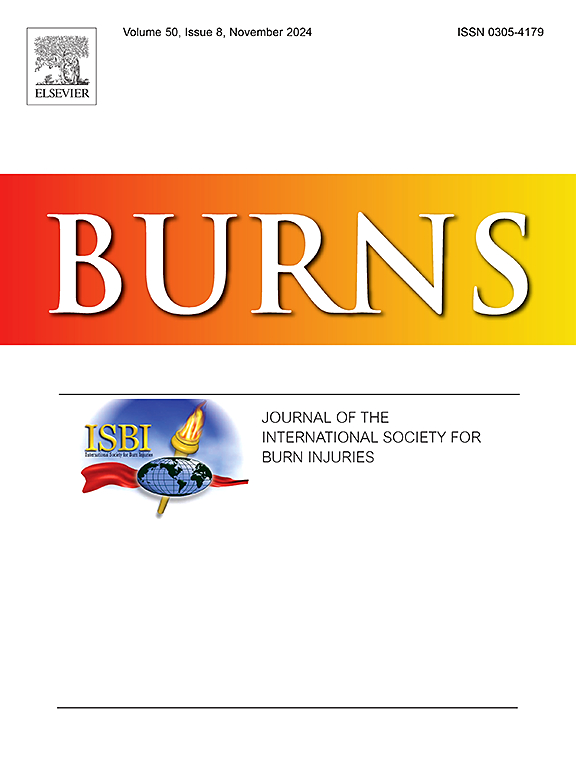The impact of negative pressure wound therapy on epidermal stem cells and keratinocyte growth factor in deep dermal burn injury: An experimental study
IF 2.9
3区 医学
Q2 CRITICAL CARE MEDICINE
引用次数: 0
Abstract
Introduction
Burns are the fourth most common accidental injury worldwide, predominantly occurring in developing countries. Wound healing in burns involves reduced cytokine secretion but increased chemokine and growth factor production compared to surgical wounds. Keratinocyte growth factor (KGF) regulates epidermal regeneration, an essential process in wound healing; while epidermal stem cells (ESCs) play a crucial role in wound closure and have potential for cell therapy. Negative pressure wound therapy (NPWT) promotes healing by improving blood flow, enhancing re-epithelialization, and reducing infection risk. This study investigates the effects of NaCl 0.9 %, intermittent and continuous NPWT, and silver sulfadiazine on ESC and KGF levels in deep dermal burns.
Method
Six male Yorkshire pigs received 20 deep dermal burns on the flank and dorsum, divided into four treatment groups: NaCl 0.9 %, continuous NPWT, intermittent NPWT, and silver sulfadiazine. Samples were collected on days 1, 3, 7, 14, and 21. ESCs were evaluated using CK19 immunohistochemistry as a marker. KGF levels were measured via ELISA. Data were analyzed with ANOVA, with significance set at p < 0.05.
Result
Continuous NPWT showed the highest ESC counts at the wound edge on all observation days and at the wound center on days 3 and 21, though without statistical significance. KGF levels differed significantly among the groups on days 1, 3, and 7 (p < 0.05), with the continuous NPWT group consistently showing the highest KGF levels. Statistical analysis revealed that treatment, observation day, and KGF levels significantly influenced ESC counts, accounting for 45 % of the variability (p < 0.05).
Conclusion
The continuous NPWT group demonstrated significantly elevated KGF levels on days 1, 3, and 7, which corresponded to a significant increase in ESC. Further research is warranted to confirm these findings.
负压创面治疗对真皮深层烧伤表皮干细胞及角化细胞生长因子影响的实验研究。
烧伤是世界上第四大最常见的意外伤害,主要发生在发展中国家。与外科伤口相比,烧伤伤口愈合减少了细胞因子分泌,但增加了趋化因子和生长因子的产生。角化细胞生长因子(KGF)调节表皮再生,这是伤口愈合的重要过程;而表皮干细胞(ESCs)在伤口愈合中起着至关重要的作用,具有细胞治疗的潜力。负压伤口治疗(NPWT)通过改善血流、增强再上皮化和降低感染风险来促进愈合。本研究探讨了NaCl 0.9 %、间断和连续NPWT和磺胺嘧啶银对皮肤深部烧伤中ESC和KGF水平的影响。方法:公约克猪6头,侧背部皮肤深度烧伤20次,分为NaCl 0.9 %、连续NPWT、间歇NPWT、磺胺嘧啶银4组。于第1、3、7、14、21天采集样品。用CK19免疫组织化学作为标志物对ESCs进行评估。ELISA法检测KGF水平。结果:连续NPWT在所有观察天伤口边缘和伤口中心的ESC计数在第3天和第21天最高,但无统计学意义。各组间KGF水平在第1、3、7天差异显著(p )结论:持续NPWT组在第1、3、7天KGF水平显著升高,与ESC显著升高相对应。需要进一步的研究来证实这些发现。
本文章由计算机程序翻译,如有差异,请以英文原文为准。
求助全文
约1分钟内获得全文
求助全文
来源期刊

Burns
医学-皮肤病学
CiteScore
4.50
自引率
18.50%
发文量
304
审稿时长
72 days
期刊介绍:
Burns aims to foster the exchange of information among all engaged in preventing and treating the effects of burns. The journal focuses on clinical, scientific and social aspects of these injuries and covers the prevention of the injury, the epidemiology of such injuries and all aspects of treatment including development of new techniques and technologies and verification of existing ones. Regular features include clinical and scientific papers, state of the art reviews and descriptions of burn-care in practice.
Topics covered by Burns include: the effects of smoke on man and animals, their tissues and cells; the responses to and treatment of patients and animals with chemical injuries to the skin; the biological and clinical effects of cold injuries; surgical techniques which are, or may be relevant to the treatment of burned patients during the acute or reconstructive phase following injury; well controlled laboratory studies of the effectiveness of anti-microbial agents on infection and new materials on scarring and healing; inflammatory responses to injury, effectiveness of related agents and other compounds used to modify the physiological and cellular responses to the injury; experimental studies of burns and the outcome of burn wound healing; regenerative medicine concerning the skin.
 求助内容:
求助内容: 应助结果提醒方式:
应助结果提醒方式:


